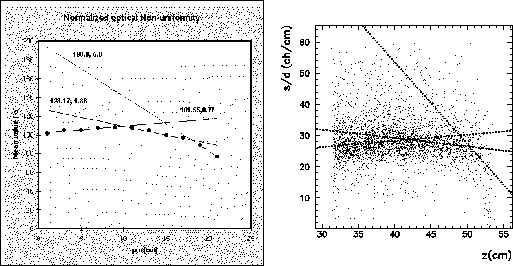



Next: Tomography of PIBETA Plastic
Up: Results and Discussion
Previous: Results of Light Output
The light output nonuniformity results from the RASTA apparatus
are reasonably consistent with those from the CMT box.
Discrepancies arise from the differing detection mechanisms in each
apparatus, and from the varying processes by which 0.66 MeV photons
(RASTA) and  1 GeV muons interact with the CsI material.
These differences are manifested as follows:
1 GeV muons interact with the CsI material.
These differences are manifested as follows:
- The 0.66 MeV photons from the
 source
are not minimum ionizing particles in the CsI. Their energy is also
below the 1.022 MeV e
source
are not minimum ionizing particles in the CsI. Their energy is also
below the 1.022 MeV e e
e pair production threshold. Therefore,
they interact with the CsI primarily through Compton scattering and the
photoelectric effect. Because materials with higher atomic number Z
are the most favored for photoelectric absorption in the
pair production threshold. Therefore,
they interact with the CsI primarily through Compton scattering and the
photoelectric effect. Because materials with higher atomic number Z
are the most favored for photoelectric absorption in the  1 MeV
range, the CsI is particularly responsive to the 0.66 MeV photons in
this way.
1 MeV
range, the CsI is particularly responsive to the 0.66 MeV photons in
this way.
Unlike the 0.66 MeV photons, the  1 GeV cosmic muons are minimum
ionizing particles, and interact by ionizing the molecules in the CsI.
In general, they exhibit very little brehmstrahlung due to their energy
and relatively large mass. Any muons which do scatter and emit
brehmstrahlung are identified as such, and are ignored to preserve
accurate tracking information.
1 GeV cosmic muons are minimum
ionizing particles, and interact by ionizing the molecules in the CsI.
In general, they exhibit very little brehmstrahlung due to their energy
and relatively large mass. Any muons which do scatter and emit
brehmstrahlung are identified as such, and are ignored to preserve
accurate tracking information.
- There is a difference in the distribution of energy deposition between
the RASTA and CMT apparatus. The cosmic muons transfer
their energy uniformly along their tracks in the CsI material. On the
other hand, while the 0.66 MeV photons from the
 Cs source can probe
the entire volume of the crystal, the Monte Carlo simulation shows that they
deposit six times as much energy near the crystal surface as they do at the
central (z) axis. [8] This feature leads to the extraction of
different optical nonuniformity coefficients, because of inherent averaging
over varying scintillation volumes in the two methods.
Cs source can probe
the entire volume of the crystal, the Monte Carlo simulation shows that they
deposit six times as much energy near the crystal surface as they do at the
central (z) axis. [8] This feature leads to the extraction of
different optical nonuniformity coefficients, because of inherent averaging
over varying scintillation volumes in the two methods.
- Finally, the position resolution of each event in the RASTA
box is determined by the position of the collimated
 Cs source, and
not through tracking with wire chamber data as in the CMT apparatus.
Cs source, and
not through tracking with wire chamber data as in the CMT apparatus.
Figure 3.11 shows the light output collection nonuniformity
slopes for hexagonal crystal S034 from both the RASTA and CMT
apparatus. There is reasonably good agreement in the region 0<z<10 cm.

Figure: Comparison of tomography results for hexagonal crystal s034, using the
RASTA apparatus (left panel) and the CMT apparatus (right panel).
The three fitted lines in each case depict the nonuniformity results for the
regions 0:10 cm, 10:18 cm, and 18:22 cm.
The tomography results for both methods are quantified for crystal S034 in
Table 3.1.

Table: Comparison of light output collection nonuniformities for
crystal S034, measured with CMT and RASTA.




Next: Tomography of PIBETA Plastic
Up: Results and Discussion
Previous: Results of Light Output
Penny Slocum
Fri Apr 2 00:36:38 EST 1999
![]() 1 GeV muons interact with the CsI material.
These differences are manifested as follows:
1 GeV muons interact with the CsI material.
These differences are manifested as follows:
![]() 1 GeV cosmic muons are minimum
ionizing particles, and interact by ionizing the molecules in the CsI.
In general, they exhibit very little brehmstrahlung due to their energy
and relatively large mass. Any muons which do scatter and emit
brehmstrahlung are identified as such, and are ignored to preserve
accurate tracking information.
1 GeV cosmic muons are minimum
ionizing particles, and interact by ionizing the molecules in the CsI.
In general, they exhibit very little brehmstrahlung due to their energy
and relatively large mass. Any muons which do scatter and emit
brehmstrahlung are identified as such, and are ignored to preserve
accurate tracking information.

